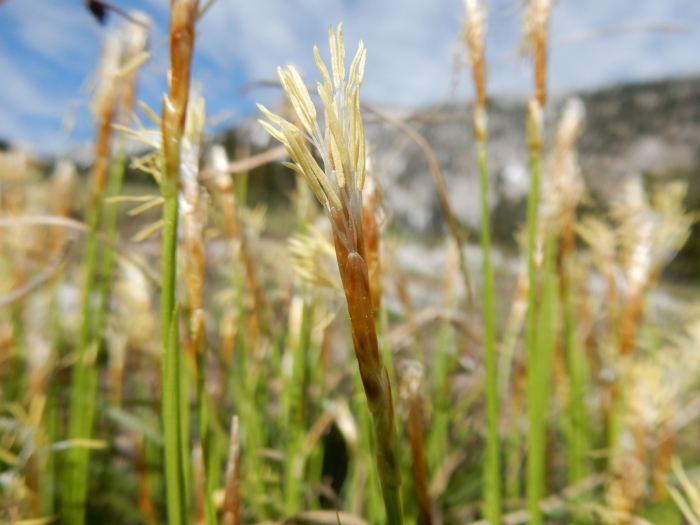Geyer’s Sedge
(Carex geyeri)
Geyer’s Sedge (Carex geyeri)
/
/

Matt Lavin
CC BY 4.0
Image By:
Matt Lavin
Recorded By:
Copyright:
CC BY 4.0
Copyright Notice:
Photo by: Matt Lavin | License Type: CC BY 4.0 | License URL: http://creativecommons.org/licenses/by/4.0/ | Rights Holder: Matt Lavin | Publisher: iNaturalist | Date Created: 2016-06-10T09:44:10-07:00 |

























Estimated Native Range
Summary
Carex geyeri, commonly known as Geyer’s sedge or elk sedge, is a perennial herb native to the montane and subalpine zones of western North America. It thrives in a variety of habitats such as dry mountain meadows, grasslands, and open forests, often in well-drained, sandy or rocky soils. Geyer’s sedge forms dense clumps or scattered tufts of stems connected by long rhizomes, which can help stabilize soil and prevent erosion. The triangular stems typically reach up to half a meter in height and bear an inflorescence composed of clusters of staminate (male) and pistillate (female) flowers, which are separated by a node and bloom in late spring to early summer.
This sedge is valued for its ability to adapt to various mountainous habitats and for its role in native plant restoration and xeriscaping, where water conservation is a priority. It requires minimal maintenance once established and is tolerant of both drought and cold temperatures. Geyer’s sedge is often used in naturalistic plantings and as a ground cover in restoration projects. It prefers full sun to part shade and well-drained soils. While generally disease-free, it can become sparse in overly moist or nutrient-rich conditions.CC BY-SA 4.0
This sedge is valued for its ability to adapt to various mountainous habitats and for its role in native plant restoration and xeriscaping, where water conservation is a priority. It requires minimal maintenance once established and is tolerant of both drought and cold temperatures. Geyer’s sedge is often used in naturalistic plantings and as a ground cover in restoration projects. It prefers full sun to part shade and well-drained soils. While generally disease-free, it can become sparse in overly moist or nutrient-rich conditions.CC BY-SA 4.0
Plant Description
- Plant Type: Grass
- Height: 1-3 feet
- Width: 1-3 feet
- Growth Rate: Slow
- Flower Color: N/A
- Flowering Season: Spring, Summer
- Leaf Retention: Deciduous
Growth Requirements
- Sun: Full Sun, Part Shade
- Water: Low
- Drainage: Fast, Medium
Common Uses
Bird Garden, Deer Resistant, Low Maintenance
Natural Habitat
native to the montane and subalpine zones of western North America
Other Names
Common Names: Elk Sedge
Scientific Names: , Carex geyeri,
GBIF Accepted Name: